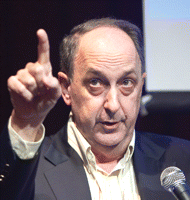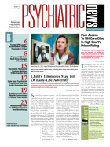Neurobiological research can help psychotherapists tailor talking therapies to the individual characteristics of patients with borderline personality disorder (BPD).
That's what Glen Gabbard, M.D., told psychiatrists at this year's APA annual meeting in Honolulu in an address titled, "Neurobiologically Informed Psychotherapy of Borderline Personality Disorder."
A prominent psychoanalyst and psychodynamic therapist, Gabbard said he believes the theoretical constructs of psychoanalysis—drives and conflicts—find expression in, and can be interpreted within, a patient's individual neurobiology. "You can see psychoanalytic meaning at the same time you are looking at biology," he said. "This was the dream of Freud, to build bridges between psychoanalytic concepts and a neurobiological science of the brain."
He is the Brown Foundation Professor of Psychoanalysis and professor and director of the Baylor Psychiatry Clinic.
In the case of BPD, Gabbard stressed the role of hyper-reactivity of the amygdala, and a corresponding inactivity of the prefrontal cortex, as well as emerging evidence that patients with BPD have an opioid deficiency. These neurobiological characteristics account for the emotional dysregulation and impulsivity common in BPD (see
Key Points Concerning Neurobiology and Psychotherapy for BPD).
"What's exciting to me is that the neurobiological research gives us an opportunity to get more specific about tailoring psychotherapies to specific borderline patients," Gabbard said. "There is a spectrum to BPD, and one of the principles we learn in medical school is to adjust the treatment to the patient, not the patient to the treatment.
"Our psychotherapeutic theories are often like churches or belief systems, and the more we can get science involved in knowing how to tailor therapies to the individual's neurobiology, the more we are a science rather than a religion."
He noted, as an example, that recent research indicates that BPD patients with dissociative symptoms may not respond as well to dialectical behavior therapy, suggesting that this subgroup of patients may need to be treated with a different approach.
Gabbard said the psychotherapies that have been proven effective in the treatment of BPD probably all "speak" to common neurobiological processes, but one especially prominent feature is the activation of the prefrontal cortex through active reappraisal of emotions generated by an overactive amygdala. "A feature common to all of the therapies is the emphasis on self-reflection and mindfulness in which one is trying to look inward and manage painful affect states," he said. "If you are actively reappraising, that appears to cause activation of the prefrontal cortex, which then modulates the amygdala" (Psychiatric News, April 1).
And he added that patients will often experience emotional pain in a physical way that is unbearable. Research by Prossin and colleagues published in the American Journal of Psychiatry in May 2010 implicates an opioid deficiency in BPD, possibly accounting for the high rate of opioid abuse among patients, as well as the high number of borderline patients among those who seek out opioids from physicians and hospitals or from illicit sources. And it is likely that the phenomenon of "self-cutting," so common in borderline patients, is related to the release of endogenous opioids that accompanies cutting.
"Opioids are involved in emotion regulation and social functioning, so it makes conceptual sense that deficits in endogenous opioids could be related to the ubiquitous dysfunction in social and interpersonal relationships," he said.
Also intriguing is the fact that patients with BPD report feeling euthymic—as opposed to euphoric—when using opioids, suggesting the neurobiologically determined difficulty they may have experiencing pleasure.
"This means satisfaction in intimacy is going to be challenging and is linked to the insecure attachment that patients experience over and over," Gabbard said. "So when we see these people having difficulty forming a therapeutic alliance, it is so important that therapists not think of them as ‘difficult’ or ‘bad’ patients, but as people who are struggling with a biological deficit they are trying to overcome in order to link up with someone in a way they may never have experienced."

